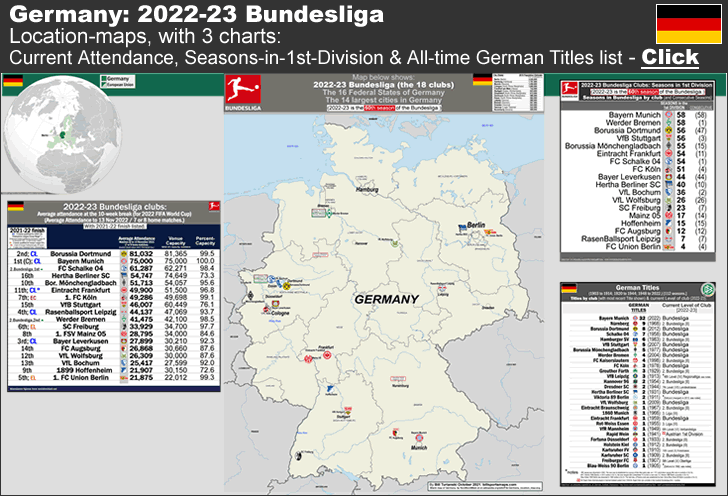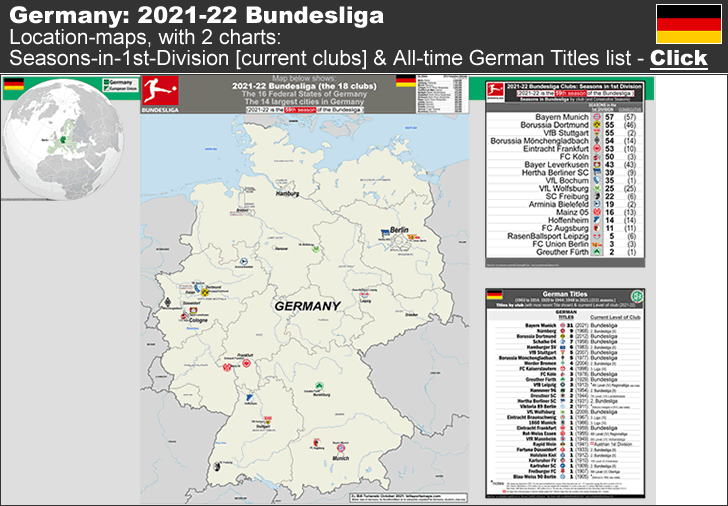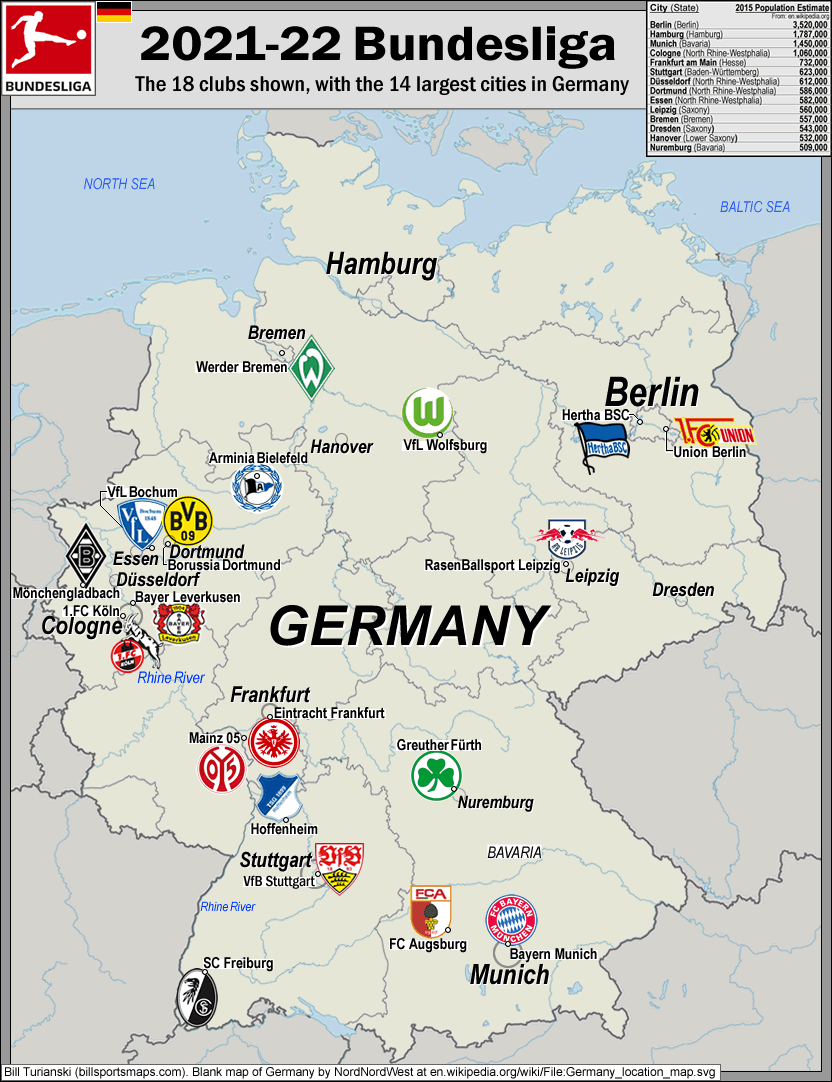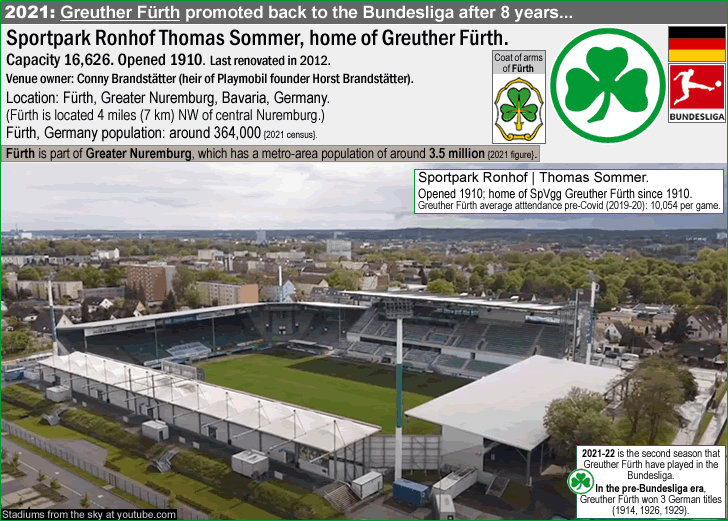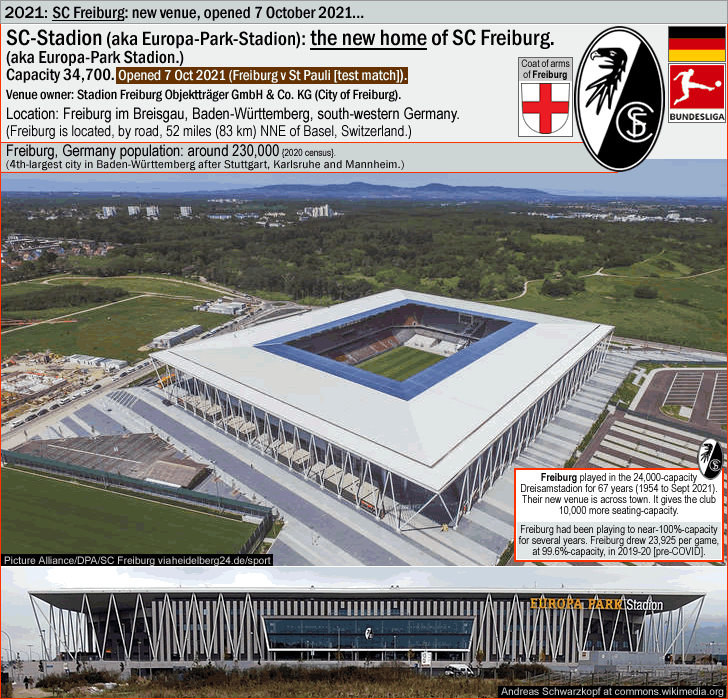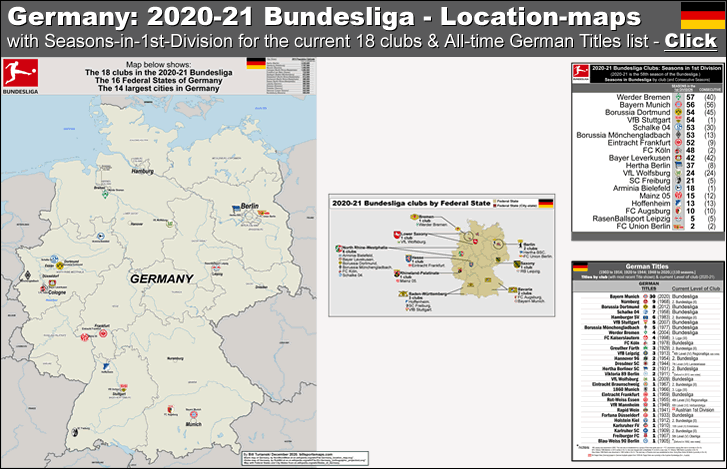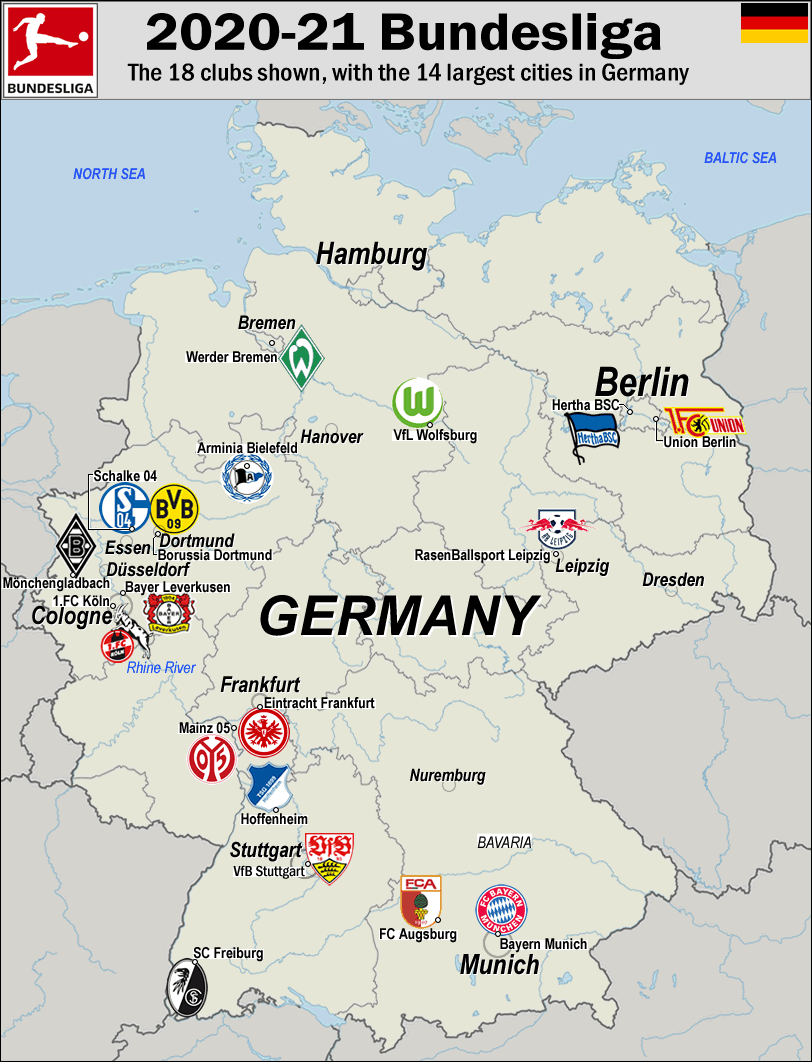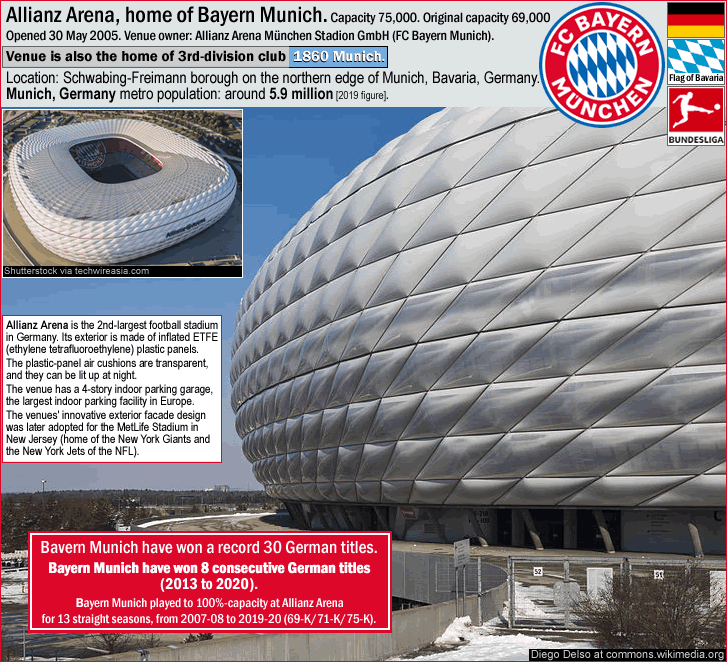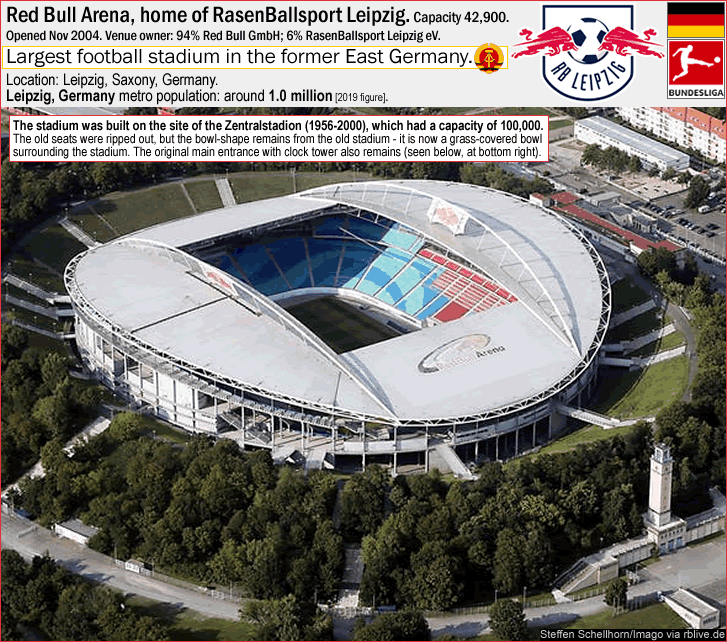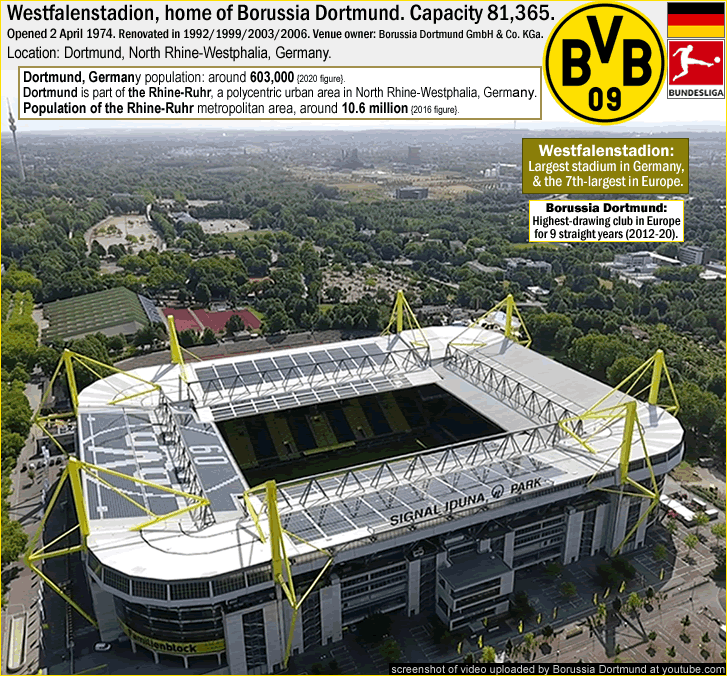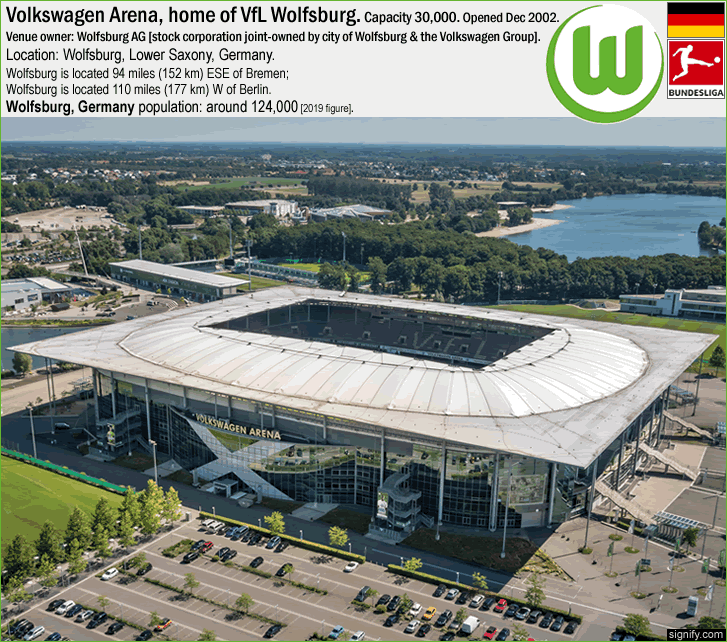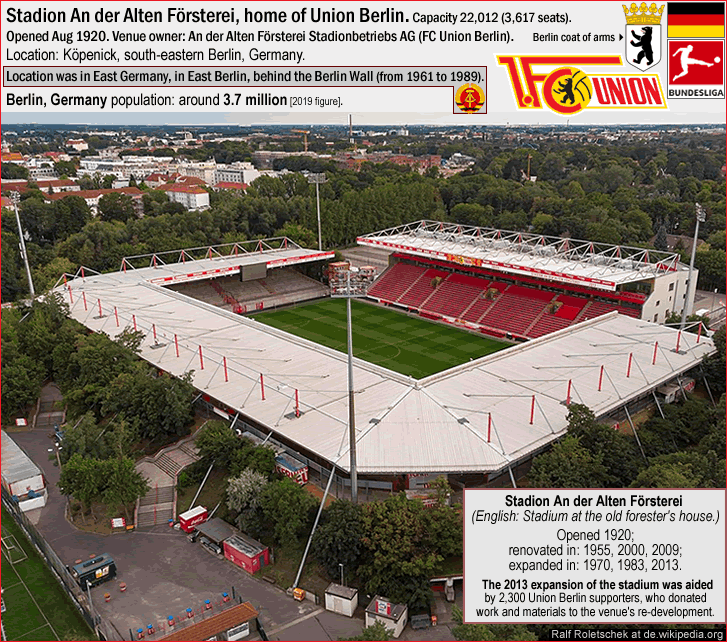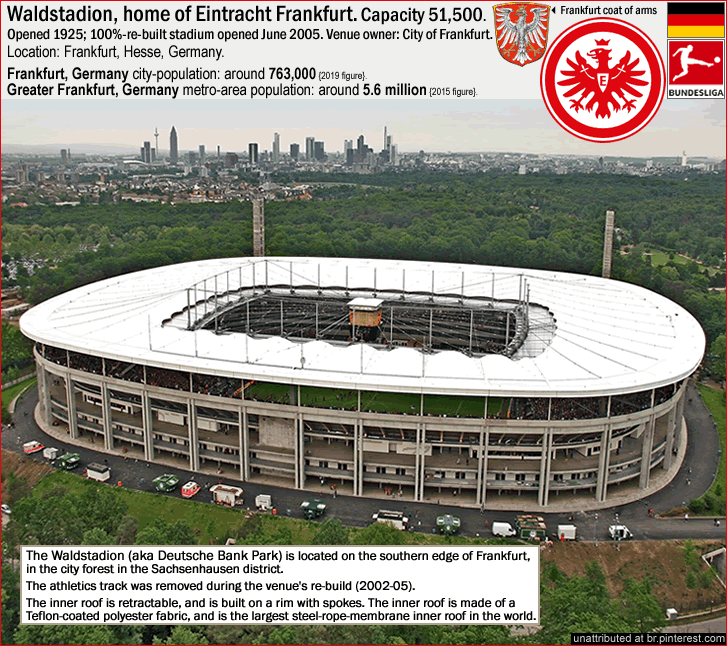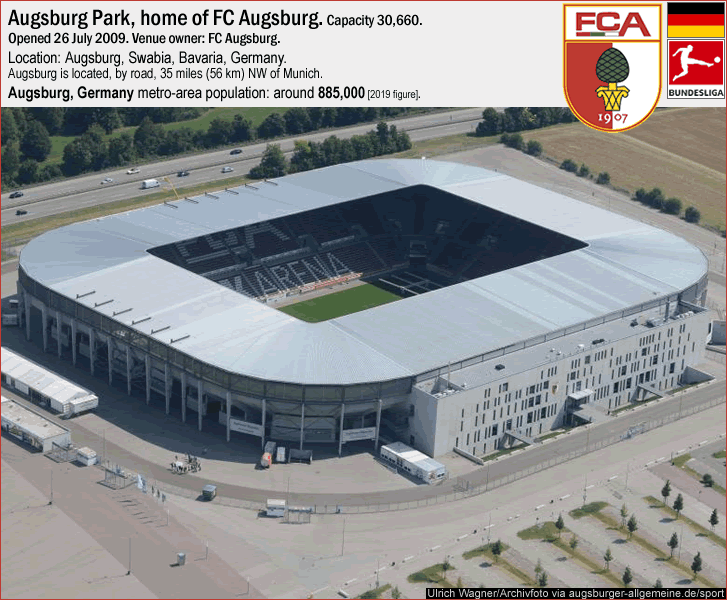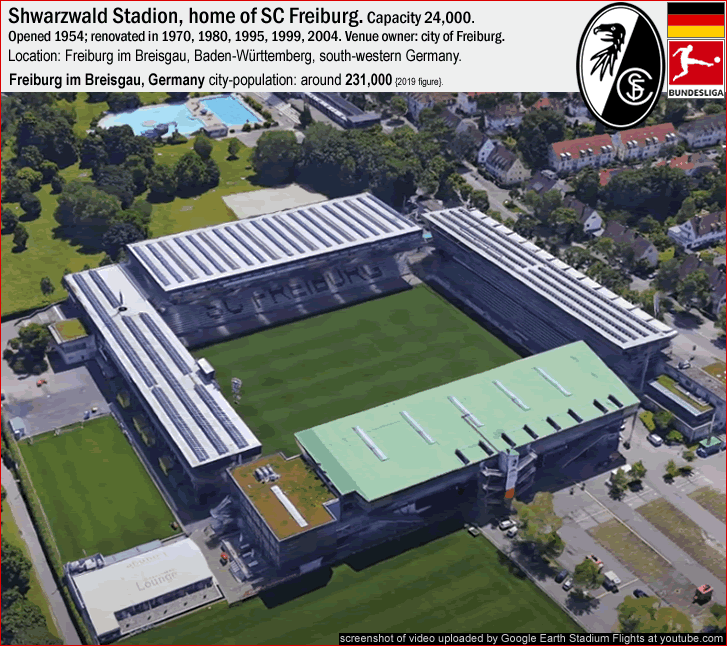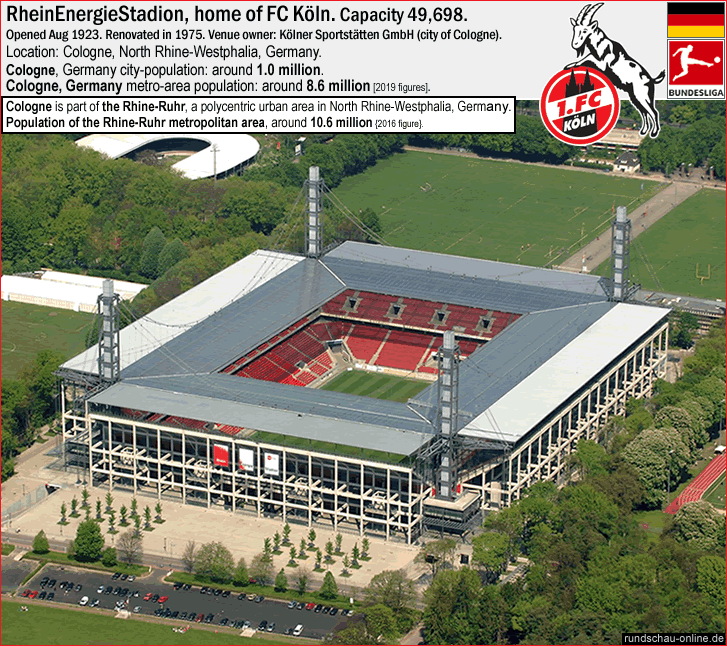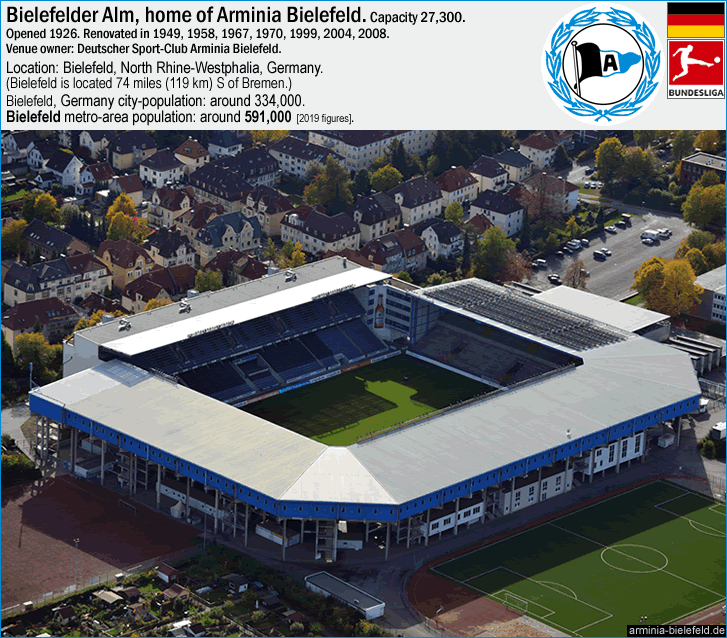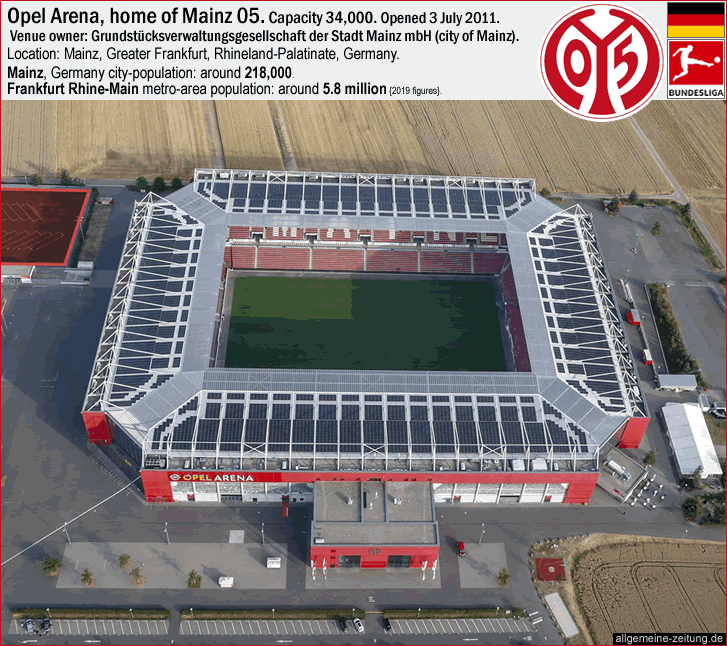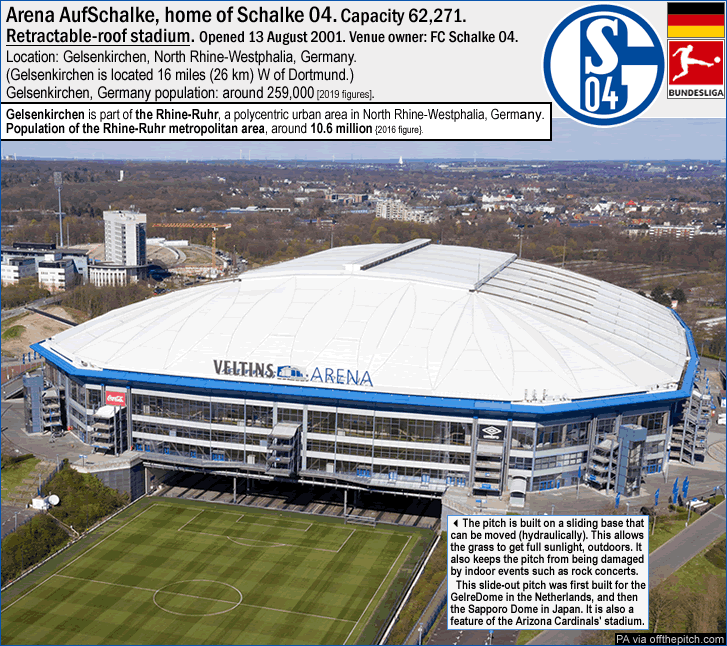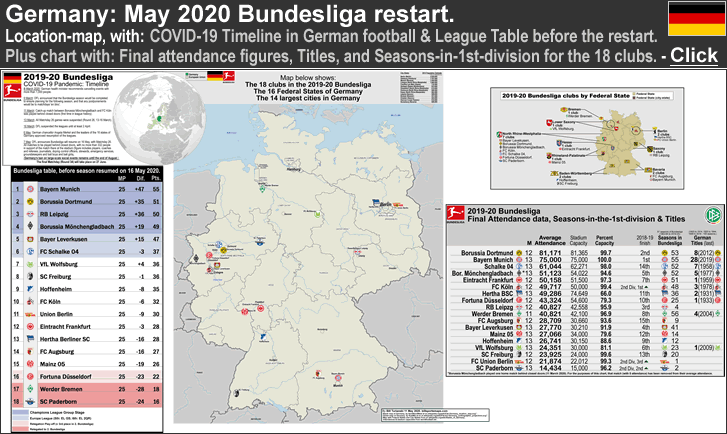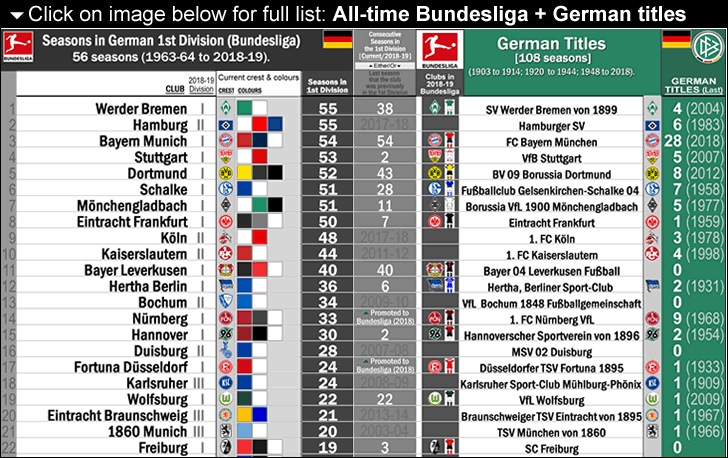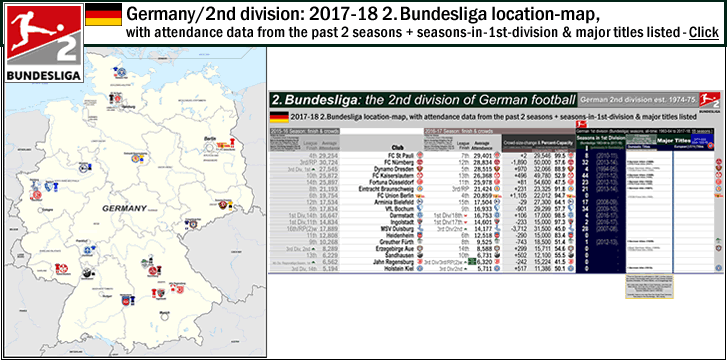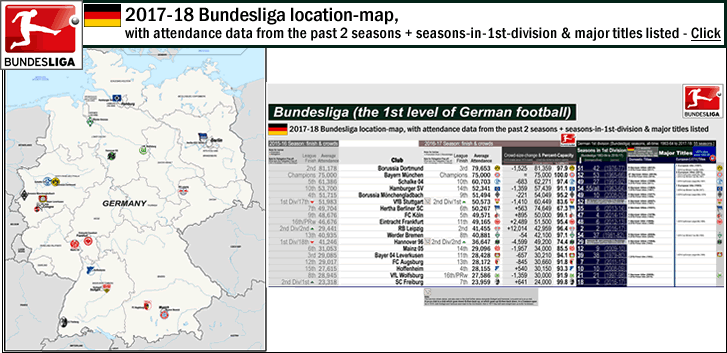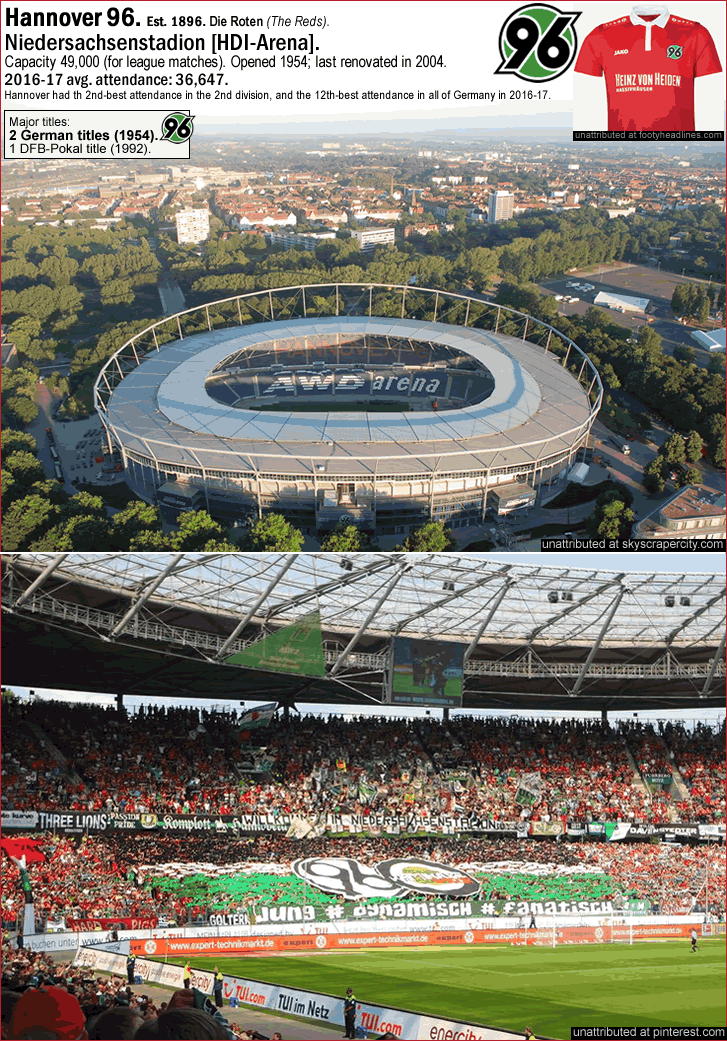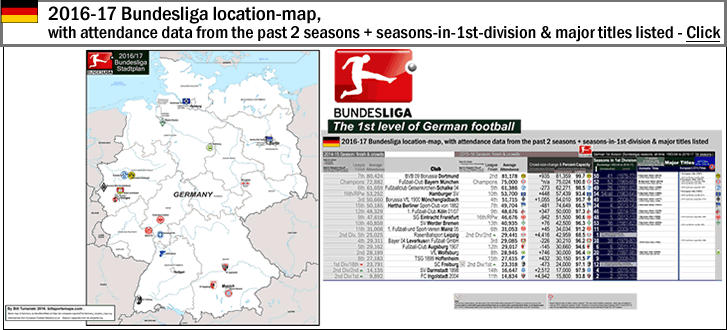
Germany: 2023-24 Bundesliga – Location-map, with 3 Charts: Current Attendance, Seasons-in-1st-Division & All-time German Titles list
…
…
By Bill Turianski on 15 September 2023; twitter.com/billsportsmaps.
Links…
-2023-24 Bundesliga (en.wikipedia.org).
-World Football.net site…worldfootball.net/bundesliga.
-All the new Bundesliga jerseys for the 2023/24 season (from bundesliga.com/en).
The map page shows a location-map for the 18 clubs in the 2023-24 Bundesliga, with recently-promoted and -relegated teams noted. (Promoted in 2023: Darmstadt, Heidenheim; relegated in 2023: Schalke, Hertha [Berlin].) The map also shows the 16 Federal States of Germany, and the 14 largest cities in Germany, with 2021 population estimates listed at the the top of the map.
The 3 charts are…
A) 2022-23 Attendance & 2022-23 finish, with teams playing in Europe noted. There are also columns listing Venue-capacities and Percent-capacities.
B) Seasons-in-Bundesliga by club, with consecutive seasons listed.
C) All-time German titles list (including the pre-1963-64/pre-Bundesliga amateur era), with current level [2022-23] of each title-winning club listed.
…
…
Thomas Tuchel’s Bayern Munich took control of the 2022-23 Bundesliga title race in week 26, on the 1st of April, when they beat Dortmund 4-2. Bayern Munich have now won an absolutely unprecedented ten straight titles. Dortmund finished in second place, even on points, but with a goal-difference that was 15 less than Bayern’s. Third place went to Rasenballsport Leipzig. And fourth place – and the coveted final German spot in the UEFA Champions League Group Stage – went to former second-division mainstay FC Union Berlin. Union Berlin have reached the Champions League Group Stage in only their fourth season of Bundesliga football {see this (dailymail.co.uk/sport)}. {Also see this: Seven Bundesliga teams to play in European competition in 2023/24 (bundesliga.com/en).} Union Berlin will play in UCL Group C, with Napoli, Real Madrid, and Braga.
Union Berlin are a club from Köpenick, Berlin (population: around 67,000). A large part of Köpenick is pine forests and expanses of water, and Köpenick is often referred to as the “green lungs” of Berlin (Grüne Lunge Berlins). During the Cold War, Köpenick was part of the Soviet sector of East Berlin, before the Berlin Wall fell down in November 1989. 1. FC Union Berlin was founded in 1966, after the East German football authorities decided there needed to be a third East Berlin club, a “civilian counterpart”, to the Army club of East Berlin (ASV Vorwärts) and to the Police club of East Berlin (SV Dynamo). So TSG Berlin was established as the Workers’ club of East Berlin, out of the merger of three existing sports clubs in East Berlin, and 3 years later, in 1966, Union Berlin emerged as the football wing of TSG Berlin. Union Berlin played 15 seasons of East German 1st-division football (in the DDR-Oberliga). And in 1968, Union Berlin won the East German Cup (the FDGB-Pokal). After German reunification in 1990, Union Berlin had a hard time advancing in the Bundesliga league-system, because at that point in time Union had been a 2nd-division East German side, and only 8 spots for East German clubs were being allotted at first, in 1991-92. The top 2 East German clubs went into the 1991-92 Bundesliga (Hansa Rostock and Dynamo Dresden); and 6 more East German clubs went into the 1991-92 2.Bundesliga. So Union Berlin ended up being a 3rd-tier club for 10 years (1991 to 2001). Union Berlin finally won promotion to 2.Bundesliga in 2000-01. Union Berlin played 18 straight seasons in the second tier (2001-’19). In 2019, when Union Berlin won promotion to the Bundesliga, they became the first Bundesliga club from the former East Berlin (and the 6th from the former East Germany, after Dynamo Dresden, Hansa Rostock, VfB Leipzig, Energie Cottbus, and RB Leipzig).
Union Berlin play at the 22.0-K-capacity Stadion An der Alten Försterei (English: Stadium at the old forester’s house). The stadium was last renovated in 2009 and last expanded in 2013, with some work carried out by over 2,300 Union Berlin supporters, who donated work and building materials. {See this 10-minute video: The Fans Who Literally Built Their Club – Union Berlin (youtube.com/uploaded by Copa 90 Stories).} In 2022-23, Union Berlin drew 21,911 per-game (at 97.5 percent-capacity). Union Berlin’s top scorer last season was Sheraldo Becker (a Dutch-born Suriname international). Their manager is the Swiss-born Urs Fischer, who, in his first season at the helm in 2018-19 got Union Berlin promoted to the Bundesliga.
Below: Stadion An der Alten Försterei, home of Union Berlin, who have gone from the 2nd tier to the Champions League Group Stage in just 5 years…
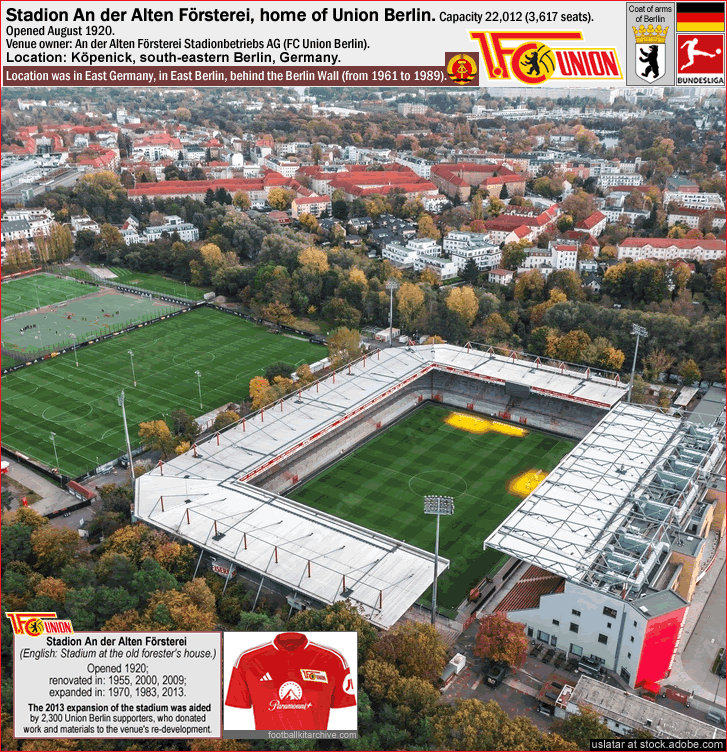
Photo credits above – uslatar at stock.adobe.com/images [October 2021]. 2023-24 FC Union Berlin jersey, photo from footballkitarchive.com.
…
…
The official Bundesliga Team of the Season 2022/23
-The official Bundesliga Team of the Season 2022/23 (bundesliga.com/en). -ea.com/games/fifa/fifa-23/ultimate-team/tots/bundesliga. -{See also, Kicker magazine Bundesliga team of the season…en.wikipedia.org/[Kicker magazine 2022-23 Bundesliga Team of the season]; Kicker magazine 2022-23 Bundesliga Team of the season (reddit.com).}

Photo credits above -
-Gregor Kobel GK (Dortmund), photo by Imago/Ostseephoto via sportbuzzer.de/fussball. -Jeremie Frimpong DF, RB (Leverkusen), unattributed at manutdnews.com. -Matthijs de Ligt DF (Bayern Munich), photo by Getty Images via fussballeuropa.com. -Nico Schlotterbeck DF, CB (Dortmund), photo by Imago via kicker.de. -Alphonso Davies DF (Bayern Munich), photo by Alexander Hassenstein/Getty Images via cbc.ca/sports. -Jude Bellingham MF (Dortmund), photo unattributed at football-espana.net. -Jamal Musiala MF (Bayern Munich), photo by Fantasista/Getty Images via bavarianfootballworks.com. -Julian Brandt MF (Borussia Dortmund), photo by Imago via ligainsider.de. -Moussa Diaby FW (Leverkusen), photo by PictureAlliance/Icon Sport via sport.fr/football. -Niclas Füllkrug FW (Werder Bremen), photo unattributed at rnz.de/sport. -Randal Kolo Muani FW (Eintracht Frankfurt), phot by Jan Huebner/Imago via fr.de.
…
…
2023: Heidenheim, promoted to the Bundesliga for the first time ever…
1. FC Heidenheim first played in the 3rd tier in 2009-10. Five years, later, in 2014, Heidenheim won promotion to the second division for the first time, joining 2.Bundesliga in 2014-15. Eight years later, in May 2023, Heidenheim won promotion to the German top flight for the first time, in dramatic fashion…on the final matchday of the season, Heidenheim scored two goals in stoppage time, to beat Jahn Regensburg. This put Heidenheim into the automatic promotion-places, at the expense of Hamburg, whose fans had already invaded their pitch in celebration {see this, from dw.com}. (Heidenheim finished top of the table, ahead of Darmstadt on goal difference.) The city of Heidenheim is in Baden-Württemberg [Southwestern Germany], and is located, by road, 53 miles (85 km) E of Stuttgart, and is just west of Baden-Württemberg’s state border with Bavaria. Heidenheim is a rather small city to be the home of a Bundesliga club (population: around 49,000). Heidenheim wear Red-and-White, and play at the 15-K-capacity Voith-Arena, which, at 1,821 feet (555 meters) above sea level, is the highest stadium in German professional football {see photos and captions below}. Heidenheim’s manager is Frank Schmidt, who has been their manager for 16 years (since 2007), and has led Heidenheim to 3 promotions. {See this article, Who are Heidenheim, the Frank Schmidt-led club who have defied the odds to make it to the Bundesliga?}

Photo credits above – Heidenheim 2023-24 jersey, from footballkitarchive.com. Heidenheim an der Brenz with the castle Helfenstein in foreground, photo by Manuel Shoenfeld/Adobe Stock via outdooractive.com. Aerial drone shot of Voith Arena, by octofly at dronestagr.am/voith-arena-heidenheim-germany.
…
…
2023: Darmstadt, promoted back to the Bundesliga after 4 years…
Darmstadt is in Hesse [Southwestern Germany], located in the southern part of the Rhine-Main-Area (Frankfurt Metropolitan Region), located 21 miles (44 km) S of Frankfurt. The city of Darmstadt has a population of around 161,000. SV Darmstadt 89 wear Blue-and-White and play at the 17.6-K-capacity Merck-Stadion. Darmstadt first played in the Bundesliga in 1978-79, but went straight back down to the second division. Darmstadt had another one-year-spell in the Bundesliga in 1981-82. In the 1990s, financial mismanagement led to the club slipping to the third and fourth divisions. In 2008, Darmstadt barely avoided insolvency, with debts of around €1.1 million. In 2011, the club won the Regionalliga Süd, and were promoted to the third division. Three years later, in 2014, Darmstadt won promotion to 2.Bundesliga for the first time in 21 years. In 2015 Darmstadt then secured their second straight promotion, by finishing in 2nd place in the 2.Bundesliga, thereby returning to the Bundesliga after a 33-year absence. Darmstadt had a 2-season-spell in the Bundesliga from 2015-2017. So for 2023-24, this will be Darmstadt’s fourth spell in the Bundesliga, but only their 5th season in the 1st division. Darmstadt’s manager is Torsten Lieberknecht, who has been their manager since June 2021.
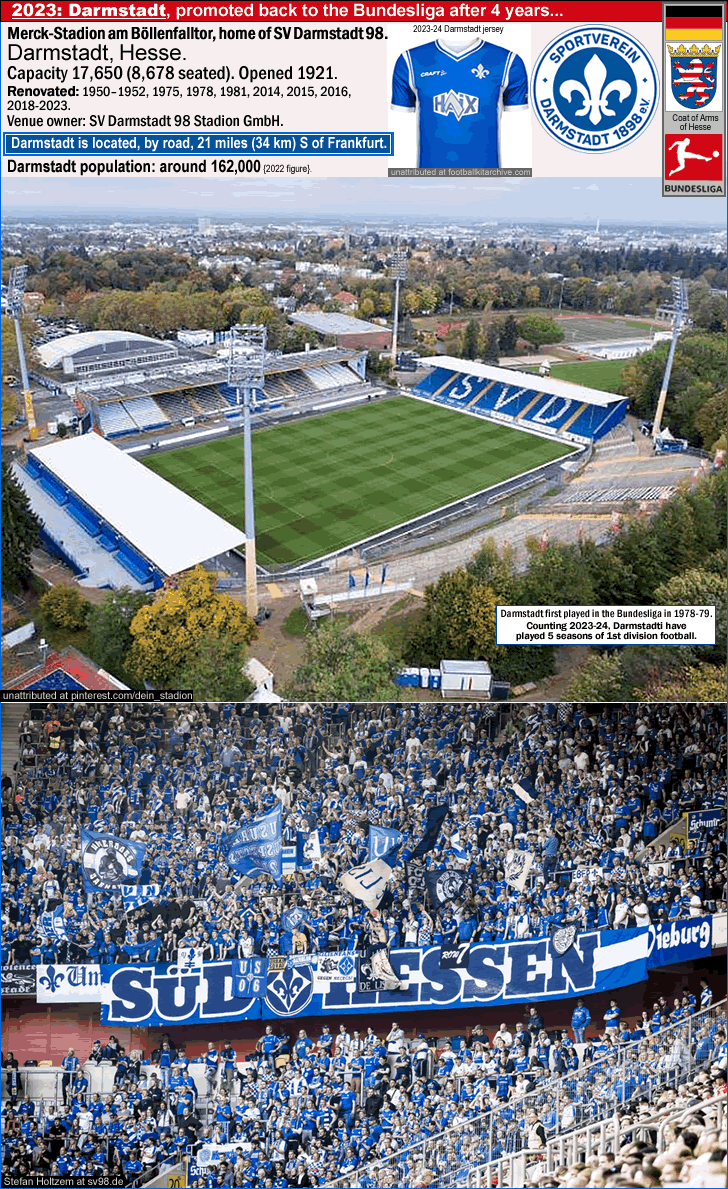
Photo credits above – Darmstadt 2023-24 jersey, from footballkitarchive.com. Merck-Stadion am Böllenfalltor, aerial drone shot, unattributed at pinterest.com/dein_stadion. Traveling Darmstadt fans with banners etc, photo by Stefan Holtzem at sv98.de/fanhinweise-zum-auswaertsspiel-in-duesseldorf.
___
Thanks to all at the following links…
-Blank map of Germany, by NordNordWest at File:Germany location map.svg (Wikimedia Commons).
-Globe-map of Germany by Rob984 at File:EU-Germany (orthographic projection).svg.
-Populations of 14 largest German cities from List of cities in Germany by population (en.wikipedia.org).
-Bundesliga; -List of German football champions (en.wikipedia.org).
-(West) Germany – List of Champions (rsssf.com).
-2022-23 attendance figures and 2022-23 capacity figures: from soccerway.com.
